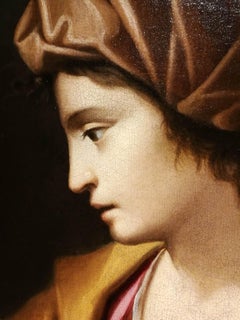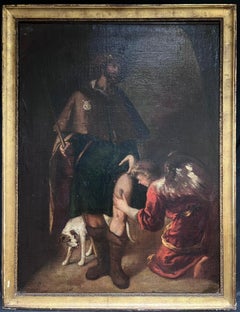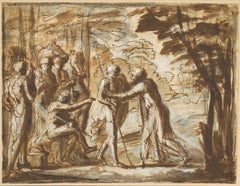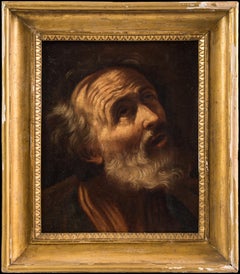Pier Francesco Mola Art
to
1
1
1
Overall Height
to
Overall Width
to
1
1
1
1
1
1
6,845
3,159
2,517
1,217
1
1
1
1
Artist: Pier Francesco Mola
Head of a Classical Poet (Socrates?)
By Pier Francesco Mola
Located in New York, NY
Provenance:
Possibly Antonio Amici Moretti, Rome, 1690
Roy Clyde Gardner, Union, Mississippi, 1970s until 2004; by whom given to:
Mississippi Band of Choctaw Indians, 2004-2010
Lit...
Category
17th Century Baroque Pier Francesco Mola Art
Materials
Canvas, Oil
Related Items
G Negri called Il Boccia Baroque Figurative Painting 17th century oil canvas
By Girolamo Negri called Il Boccia
Located in Florence, IT
Oil on canvas, 62 x 51 cm (without the frame)
Even if on the background there is an attribution to “Francesco Gessi pupil of Guido Reni” by the bolognese art historian Guido Zucchini (dated 1945), recent studies are tending to add it to the corpus of Girolamo Negri called Il Boccia (Bologna 1648-1718) due to lots of similarities with his style (the pale and warm palette chosen, the profile)
The painting represents a lady on profile wearing a brown turban, a yellow clock...
Category
Late 17th Century Baroque Pier Francesco Mola Art
Materials
Canvas, Oil
Huge 17th Century Spanish Old Master Oil Painting Wounded Pilgrim with Angel
Located in Cirencester, Gloucestershire
The Pilgrim and Angel
Spanish School, 17th Century
oil on canvas, gilt framed
framed: 48 x 37 inches
canvas: 43 x 32 inches
provenance: private collection, Barcelona, Spain
condition...
Category
17th Century Baroque Pier Francesco Mola Art
Materials
Canvas, Oil
Continence of Scipio, Erasmus Quellinus, School Rubens, Baroque Art, Old Master
By Erasmus Quellinus the Younger
Located in Greven, DE
Erasmus Quellinus
The Continence of Scipio
Oil on Canvas
The painting is included in the Catalogue Raisonné of the artist.
The Roman commande...
Category
17th Century Baroque Pier Francesco Mola Art
Materials
Oil, Canvas
Free Shipping
H 42.52 in W 64.18 in
17th century English figure painting - Portrait nobleman - Oil on canvas
Located in Varmo, IT
English painter (17th century) - Portrait of a gentleman.
73.5 x 63.5cm.
Oil on canvas, unframed.
Condition report: Canvas applied on panel. Good state of conservation of the pict...
Category
Mid-17th Century Baroque Pier Francesco Mola Art
Materials
Canvas, Oil
Free Shipping
H 28.94 in W 25.01 in
Baroque painter (Italian school) - 18th century figure painting - Saint Peter
Located in Varmo, IT
Italian painter (18th century) - St. Peter.
44.5 x 34cm.
Antique oil painting on canvas, without frame.
Condition report: Lined canvas. Good state of conservation of the pictorial...
Category
Early 18th Century Baroque Pier Francesco Mola Art
Materials
Oil, Canvas
Free Shipping
H 17.52 in W 13.39 in
'Rebekah at the Well', Follower of Luca Giordano, Early 19th Century Figural Oil
Located in Santa Cruz, CA
An early 19th century, figural oil of a young woman with chestnut hair, shown wearing a headscarf and glancing towards the viewers left. A detail from a copy of 'Rebeca at the Well',...
Category
19th Century Baroque Pier Francesco Mola Art
Materials
Canvas, Masonite, Oil
H 16 in W 13.75 in D 0.13 in
PHILOSOPHER - Dutch, Flemish, Baroque - Figurative Oil on Canvas Painting
By Ciro De Rosa
Located in Napoli, IT
Philosopher - Ciro De Rosa Italia 2008 - Oil on canvas cm. 26x26
Gold leaf gilded wooden frame available on requestThe evocative portrait of Ciro De Rosa portrays an elderly man with...
Category
Early 2000s Baroque Pier Francesco Mola Art
Materials
Oil, Canvas
Old man elderly oil on board painting
Located in Barcelona, Barcelona
Anonymous - Old man - Oil on board
Oil size 34x25 cm.
Frameless
Category
1920s Baroque Pier Francesco Mola Art
Materials
Canvas, Oil
Portrait Of A Noblewoman. Attributed To Carlo Ceresa. About 1640.
By Carlo Ceresa
Located in Firenze, IT
Portrait of a noblewoman.
Attributed to Carlo Ceresa. (1609 - 1679, Bergamo)
Oil on canvas.
Size cm 110x86,5cm with frame
Around 1640.
This portrait depicts a middle-aged woman w...
Category
Mid-17th Century Baroque Pier Francesco Mola Art
Materials
Oil, Canvas
H 43.31 in W 34.06 in D 1.58 in
PHILOSOPHER - Neapolitan School - Italian- Figurative Oil on canvas painting
By Ciro De Rosa
Located in Napoli, IT
Philosopher - Ciro De Rosa Italia 2008 - Oil on canvas cm. 60x50
Gold leaf gilded wooden frame available on request
The painting by the painter Ciro De Rosa portrays an old and wise ...
Category
Early 2000s Baroque Pier Francesco Mola Art
Materials
Canvas, Oil
Study for a Man, Young man, Italian or Dutch School, 17th Century, Old Master
Located in Greven, DE
Study for a Man, perhaps Italian School , Follower of Caracci. Old Master Painting.
In a Golden Frame, 52 x 46 cm.
Category
17th Century Baroque Pier Francesco Mola Art
Materials
Canvas, Oil
Portrait of an English Gentleman "Sir"
Located in Soquel, CA
Portrait of a nobleman by an unknown artist , titled "Sir" on a London label on verso. A man dressed in dark robes with a white collar looks directly at the viewer. Heavy age toning ...
Category
Late 18th Century Baroque Pier Francesco Mola Art
Materials
Oil, Canvas
Previously Available Items
Joseph greeting his Brothers, a preparatory study by Pier Francesco Mola
By Pier Francesco Mola
Located in PARIS, FR
The attribution of this drawing to Pier Francesco Mola has been confirmed by Dr. Francesco Petrucci, an expert of the artist.
This extraordinary study was executed around 1656 by Pier Francesco Mola, one of the masters of the Roman Baroque. With great technical virtuosity, Mola combines a preparatory drawing executed in red chalk and pen with washes of grey and brown inks and highlights of white lead. Although very different from the final outcome, it is probably an early thought for the fresco the artist painted in the gallery commissioned by Pope Alexander VII for the Quirinale Palace, a fresco which, according to the British art historian Ann Sutherland Harris, was "his largest single composition and probably the most prestigious commission of his career”.
1. Pier Francesco Mola, a painter of Baroque Rome
Pier Francesco Mola was born in Coldrerio, Ticino, near Lugano, on 9 February 1612. His father Giovanni Battista was a well-known architect and the family moved to Rome in 1616, where Pier Francesco spent most of his career.
Trained in the workshops of the Cavaliere d'Arpino (1568 - 1640) and Domenico Zampieri, known as Dominichino (1581 - 1641), Mola made two jouneys to northern Italy, one from 1633 to 1640, and the second from 1641 to 1647, which led him to stay in Bologna and Venice, before returning to settle permanently in Rome. He was also influenced by the classicism of Francesco Albani (1578 - 1660), whose workshop he frequented.
While Joseph greeting his brothers is his main fresco, Pier Francesco Mola was also an important painter of easel paintings. A leading figure in the neo-Venetian movement in Rome, alongside Pietro Testa (1617 - 1650) and Andrea Sacchi (1599 - 1661), he sought to reconcile Bolognese aesthetics with Venetian colour. He sometimes collaborated with Gaspard Dughet, and at the end of his life (1660-1666) he also revealed himself as a great landscape painter. He was linked to the Franco-Roman classical milieu (Poussin, Lorrain and Dughet), giving his figures a realism close to Ribera’s.
His graphic work has always been sought after, particularly across the Channel, as the early provenance of the sheet we are presenting demonstrates. It comes from one of the most prestigious collections formed in England in the second half of the 18th century, that of the painter Sir Joshua Reynolds (1723 - 1792), who was the first president of the Royal Academy from 1768 onwards.
2. Description of the artwork
Pier Francesco Mola displays here all the facets of his talent, and in particular his very specific way of incorporating figures into a lush landscape. Our study focuses on the figures of Joseph and Benjamin, recounting the moment when the latter " fell upon his brother Benjamin's neck and wept" (Genesis 45-14).
This episode terminates the story of Joseph, who had been sold by his brothers to merchants who took him to Egypt, where he became Pharaoh's trusted man, interpreting his dreams. Thanks to him, Pharaoh built up stocks of food during the seven years of plenty, which enabled him to feed his people during the seven years of famine. Joseph's hungry brothers came to buy grain from him and returned a second time with Joseph's younger brother Benjamin at Joseph’s request. This is the moment that Joseph chooses to reveal his true identity to his brothers, showing special tenderness for Benjamin, his own mother's only other son.
While Joseph rushes towards Benjamin with ardour, Benjamin seems more reserved as he advances towards Joseph, suggesting perhaps that it is the forgiver who must make the first move. "Benjamin wept upon his neck," adds the Genesis, and this weeping is evoked by his left arm being folded as if to hide his tears.
The figures of Joseph and Benjamin were probably the main concern of the painter in this study. Their half-brothers are depicted in the background, massed to the left of the study. Their static silhouettes, sketched in a rather schematic manner, contrast with the dynamism of the encounter between Joseph and Benjamin, whose clothes flutter as if animated by a light wind.
The complex technique of this study places it at the borderline between drawing and painting, thanks in particular to the white lead highlights that give life to the two main figures, and to the very fluid ink washes, as for example in the representation of the grove of trees on the right.
Much of the charm of this drawing lies in the evocative description of the landscape - probably the banks of the Nile - in which the artist introduces an impression of depth by evoking the reflection of the trees in the water in the background of the composition.
3. A long maturation for the subject
The gallery of the Palazzo del Quirinale is one of the great commissions of the pontificate of Alexander VII. It was entrusted to Pietro da Cortona in 1655, who was responsible for bringing together a group of artists to carry out this decorative programme. At the end of the gallery two scenes were executed by the two main painters who participated in this vast decorative programme: the Adoration of the Magi by Carlo Maratta and Joseph greeting his Brothers by Pier Francesco Mola. This arrangement takes up the idea of associating an Old Testament scene with a New Testament scene, and we can see in the story of Joseph who makes himself known to his brothers at the height of his power a counterpoint to the humility of the birth of Christ, recognised by the shepherds.
Numerous preparatory drawings for this fresco have survived, reflecting the importance of this papal commission for Pier Francesco Mola. In his book published in 1972, Richard Cocke lists 12 known preparatory studies. Our drawing, which was kept in private collections at the time, has not yet been studied by art historians, but we shall see, by focusing on the evolution of the figure of Joseph, that it is most probably be a very early thought, executed before the one kept in the British Museum, which was considered by this art historian to be the oldest drawing in the series.
In this composition (9th photo of the gallery), made on an inverted basis, we find the three figures formed by Joseph, who is represented in a manner very similar to that of our drawing, Benjamin, who has become a young adolescent, and one of the brothers whose arm balances, as in our drawing, that of Joseph.
This brother is now depicted standing instead of sitting, giving the composition more dynamism. The group of the other brothers unfolds like an antique frieze in a mineral landscape in which vegetal references have disappeared. As in the drawing in the Musée Atget in Montpellier and as in our study, Mola presents Joseph running to greet Benjamin in an intimate and personal gesture that does not include his other brothers.
The next stage in the evolution of the composition is presented to us in a study in the Museum Kunstpalast in Düsseldorf (10th photo of the gallery) in which Mola depicts Joseph with his arms open, including all his brothers in his greeting.
Whereas in the first sketches Joseph was depicted as a bearded middle-aged man - which was consistent with the fact that he is around forty years old according to the Bible at the time of this meeting - Mola later rejuvenates him, as he looks closer in age to Benjamin.
The following preparatory studies are entirely devoted to the complex arrangement of the group of brothers. In the final composition (last photo of the gallery), this group is now split into two parts: six of them are shown kneeling in a deferential position. Benjamin is shown standing with his arms folded in the background, in front of four other brothers who are also standing. It is also interesting to note that this final composition reintroduces the vegetal background, as we are now in a courtyard bordered by a balustrade beyond which lush gardens extend. Their trees look quite similar to those represented in the right of our study.
4. A prestigious provenance: Sir Josuah Reynolds
Sir Joshua Reynolds (Plympton 1723 - London 1792) can be considered as the leader of the English school of painting in the 18th century. Specialising in portraiture, he was the co-founder and first president of the Royal Academy. His youth was marked by a long journey to Italy between 1749 and 1752 and his favourite masters remained throughout his life Michelangelo, Raphael, the other Italians of the 16th century and Claude Gellée.
He was the most discerning collector among the painters of his time. His eclecticism, constantly in search of the "great style", is evident both in his lectures at the Royal Academy and in the choice of his collections, to which he devoted a large part of his income. We don’t know whether he started buying some drawings in Italy or whether those were only purchased after his return to England.
In his 8th lecture, Reynolds describes the charm that drawings held for him in terms that apply quite well to the drawing we are presenting: “From a slight, undetermined drawing, where the ideas of the composition and character are, as I may say, only just touched upon, the imagination supplies more than the painter himself, probably, could produce; and we accordingly often find that the finished work disappoints the expectation that was raised from the sketch. “
The bulk of his drawings were sold at auction on 26 May 1794 and again from 5 March 1798. The mark in the lower right corner of our drawing was inscribed by his executors on Reynolds' death. They marked the 1163 best drawings (of which our sheet was part) on the recto, while the inferior drawings were stamped on the verso.
This drawing has since been kept in the UK. His last known owner was the writer Anthony Powell...
Category
1650s Old Masters Pier Francesco Mola Art
Materials
Chalk, Ink, Pen
Pier Francesco Mola attributed to (Rome 1612 - Rome 1666) - Head of Character
By Pier Francesco Mola
Located in Varmo, IT
Pier Francesco Mola, called Il Ticinese (Coldrerio 1612 - Rome 1666) assigned to - "Head of character".
42 x 34 cm without frame, 55.5 x 48 cm with frame.
Oil on canvas, in gilded ...
Category
Mid-17th Century Old Masters Pier Francesco Mola Art
Materials
Oil
Pier Francesco Mola art for sale on 1stDibs.
Find a wide variety of authentic Pier Francesco Mola art available for sale on 1stDibs. You can also browse by medium to find art by Pier Francesco Mola in canvas, fabric, oil paint and more. Not every interior allows for large Pier Francesco Mola art, so small editions measuring 15 inches across are available. Customers who are interested in this artist might also find the work of Giovan Battista Viola, Sir Peter Lely, and Suzi Fadel Nassif. Pier Francesco Mola art prices can differ depending upon medium, time period and other attributes. On 1stDibs, the price for these items starts at $45,000 and tops out at $45,000, while the average work can sell for $45,000.




